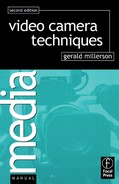In the Field– The Single Camera
Four basic forms of single-camera unit are used regularly for ENG, EFP, SNG, and certain forms of studio production —
• The independent camcorder, where the video camera has an attached or incorporated videotape recorder, and produces videotape recordings for subsequent editing.
• The stand-alone camera which is cabled to a separate portable videotape recorder in a shoulder-bag, back-pack, or on a trolley-pack.
• The stand-alone camera working to a nearby support vehicle. That can be anything from a station wagon, remotes truck/van, to a mobile control room. The program material may be recorded there, or passed on directly to a distant control center.
The camera’s maximum distance from its base largely depends on the kind of transmission link used:
Cable – Multicore, triaxial, coaxial, or fiber-optic. Each form has its particular practical advantages. Fiber-optic types are lighter, less bulky, more easily transported, easier to route (they can be suspended, wall-taped or buried), and can be used over much greater distances – e.g. up to 3000 meters (1.8 miles); about five times that of multicore cables.
Microwave link – Portable and camera-mounted video/audio relays.
I.R. link – Infra-red line-of-sight transmission to the base station.
• The stand-alone camera feeding a portable/mobile satellite up-link unit.
In the field, shoulder-mounted lightweight cameras are widely used for maximum mobility. But this method of supporting the camera becomes quite tiring after a while. Even with the aid of a body-brace it is not possible to hold a camera absolutely still, shot after shot for long working periods. When you have to use a narrow-angle (long focus) lens to get a close enough shot of the subject, your own natural movements can make a certain amount of unsteadiness unavoidable (heart beat, breathing, tired muscles).
If you are going to walk around while shooting, try to check your route beforehand for any obstacles. There are many potential hazards for the unwary, such as uneven ground, cables, rugs, stairs, low furniture, wet floors. Develop the habit of keeping both eyes open while looking into the viewfinder, so that you always remain aware of your surroundings.
You can pick up sound on location with either a camera microphone, or a separate microphone held by someone else. (The latter can provide better and more consistent sound quality.) You can record the audio on a sound track of the videotape recording, or on a separate sound recorder. Time-code tracks help to identify and synchronize picture and sound.
Although the picture will occupy most of your attention, if you are working unaided don’t forget to continually monitor the sound, even if only on an earpiece. It may be catastrophic if you finish up with great pictures but unusable sound. And beware, the noise of footsteps walking across a gravel path may be your own!
It may seem a chore to carry a tripod around, but unless shots are brief, you will soon welcome the stability it offers. A tripod can seem to develop a will of its own; so here are some hints for using them successfully:
• Tripods can become top-heavy and overbalance if their legs are not fully spread and properly adjusted, especially on uneven ground.
• Unless the tripod is very firmly based or bottom weighted, do not leave your camera unattended. If the pan-head is not tightly locked off, you may find the camera tilting and unbalancing the tripod.
• There are two kinds of ends to tripod feet: spikes that grip rough ground (but will pit, scratch, or slide on other surfaces), and non-slip rubber end-pieces for smooth or easily-damaged floors.
• Always make sure that the tripod is level, and the camera correctly balanced. Apart from any built-in level indicator, you can check by locking the tilt action, and panning around. If the tripod needs leveling, horizontals will tilt down on one side (the leg that is too low).
• You should normally fully extend all three legs of the tripod. The exception is when you deliberately shorten a leg to suit uneven ground, rocky terrain, or a staircase.
• To improve a tripod’s stability, and/or prevent its feet from sinking into the ground, fix its feet onto a special spreader or base-plate.
